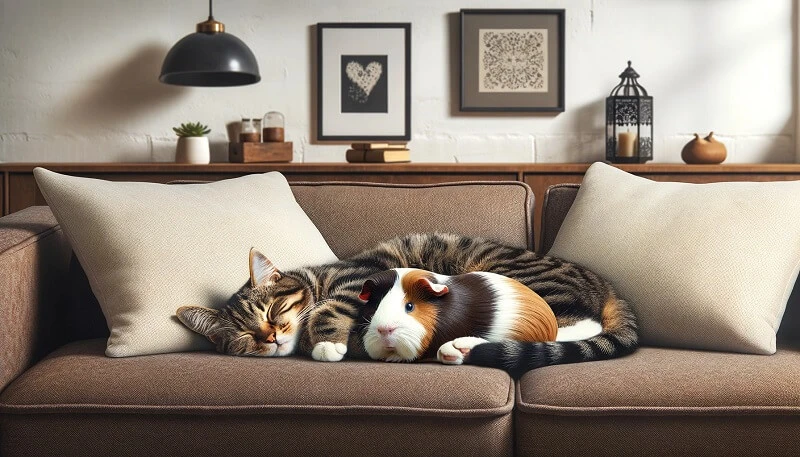Pet owners often ponder whether they can interchange pet foods among different pets, such as feeding cat food to guinea pigs. This article aims to address this query with an emphasis on the specific dietary needs of guinea pigs, contrasting them with those of cats. Understanding these differences is crucial for maintaining the health and well-being of our beloved guinea pig companions.
Can Guinea Pigs Eat Cat Food?
Guinea pigs should not eat cat food due to different dietary needs. Guinea pigs are herbivores. They need a fiber-rich diet of plants and veggies. Cats, on the other hand, are carnivores. They require animal protein. Feeding cat food to guinea pigs can cause digestive issues like bloating and discomfort. Their systems aren’t designed to digest high-protein animal food.
Cat food lacks essential vitamins and minerals that guinea pigs need from their natural diet. It’s important to keep guinea pigs on their recommended fresh vegetables and hay diet. It’s important for their health and wellbeing.
What Should Guinea Pigs Really Eat?
Related Article: Guinea Pig Care Guide: Must-Knows for New Owners
Now that we’ve established the “no cat food for guinea pigs” rule, let’s talk about the delicious, nutritious options. These will keep your little veggie enthusiast bouncing with joy!
Hay: The Superfood of the Guinea Pig World
- Think of hay as the main course on your guinea pig’s menu. It’s packed with fiber, keeping their digestive system humming and their teeth worn down (they never stop growing!).
- Aim for unlimited access to high-quality grass hay, like orchard grass or timothy hay. It’s like a never-ending salad bar for your furry friend!
Related Article: Ticking Hay-Clock: How Long Can a Guinea Pig Go Without Hay?
Veggies: The Vitamin Powerhouse
- Fresh veggies are like the side dishes that add flavor and essential vitamins to your guinea pig’s diet. Aim for a daily serving, about the size of your guinea pig’s head.
- Go green with romaine lettuce, spinach, and kale. Mix it up with bell peppers, carrots, and broccoli for a tastebud adventure. Don’t forget fruits like apples and strawberries as occasional treats!
Pellets: The Nutritional Nuggets
- Guinea pig pellets are like multivitamins in crunchy form. They provide essential nutrients that might be missing in hay and veggies alone.
- Choose pellets specifically formulated for guinea pigs, not rabbits or other small animals. Look for brands low in protein and rich in vitamin C, as guinea pigs can’t produce it themselves.
Bonus Tips for a Happy Tummy
- Introduce new foods slowly, one at a time, to avoid digestive upset.
- Wash all vegetables thoroughly before serving.
- Avoid iceberg lettuce, which is low in nutrients and can cause diarrhea.
- Keep fresh water available at all times.
By sticking to hay, veggies, and guinea pig-specific pellets, you’re giving your furry friend the fuel they need for zoomies, popcorn celebrations, and all the other adorable guinea pig antics!
Nutritional Showdown: Cat Food vs. Guinea Pig Pellets
| Nutrient | Cat Food | Guinea Pig Food |
|---|---|---|
| Protein | High (meat-based) | Low (plant-based) |
| Fat | High | Moderate |
| Fiber | Low | High |
| Vitamin C | Low/None | High (Essential) |
| Carbohydrates | Low | Moderate to High |
What does this table tell us?
- Protein Powerhouse: Cat food packs a protein punch for their muscle-building needs, while guinea pigs thrive on moderate protein and rely on fiber for energy.
- Fat Frenzy: Both have decent amounts of fat, but guinea pig pellets lean lighter.
- Fiber Famine: The key difference lies in fiber. Cat food lacks this gut-health booster, while guinea pig pellets are loaded with it, keeping their digestive system happy and teeth trimmed.
- Vitamin C Void: Missing in cat food, this vital nutrient is present in guinea pig pellets. As guinea pigs can’t make their own, it’s crucial in their diet.
- Calorie Counts: Both offer similar calorie content, though slightly less in guinea pig pellets, reflecting their lower energy needs than felines.
This comparison highlights the stark differences in the nutritional needs of cats and guinea pigs. Cat food is perfectly suited for cats. However, it lacks the fiber and essential vitamins that guinea pigs need for a healthy life. Sticking to hay, veggies, and specifically formulated guinea pig pellets is the recipe for a happy, healthy, and bouncing guinea pig!
The Health Risks of Feeding Cat Food to Guinea Pigs
It’s crucial for responsible pet care to understand the health risks of guinea pigs eating cat food. While curiosity might lead them to nibble on cat food, this can result in serious health implications.
- Firstly, cat food’s high protein content can strain a guinea pig’s kidneys. This can potentially lead to kidney diseases.
- Secondly, the lack of fiber disrupts their delicate digestive system. This causes gastrointestinal distress like bloating, gas, and diarrhea.
- Also, cat food’s nutritional imbalance can lead to obesity in guinea pigs. This can lead to health problems, such as heart issues and limited movement.
- The absence of vital nutrients such as Vitamin C in cat food can also lead to nutritional deficiencies. This can adversely affect their overall health.
Conclusion
We’ve seen why cat food isn’t suitable for guinea pigs. We focused on their need for fiber-rich diets and the digestive risks of cat food. A guinea pig’s diet should include hay, fresh vegetables, and Vitamin C-rich pellets. It’s crucial to avoid cat food. Provide a diet tailored to their herbivorous nature. This ensures your guinea pig’s health and happiness.

